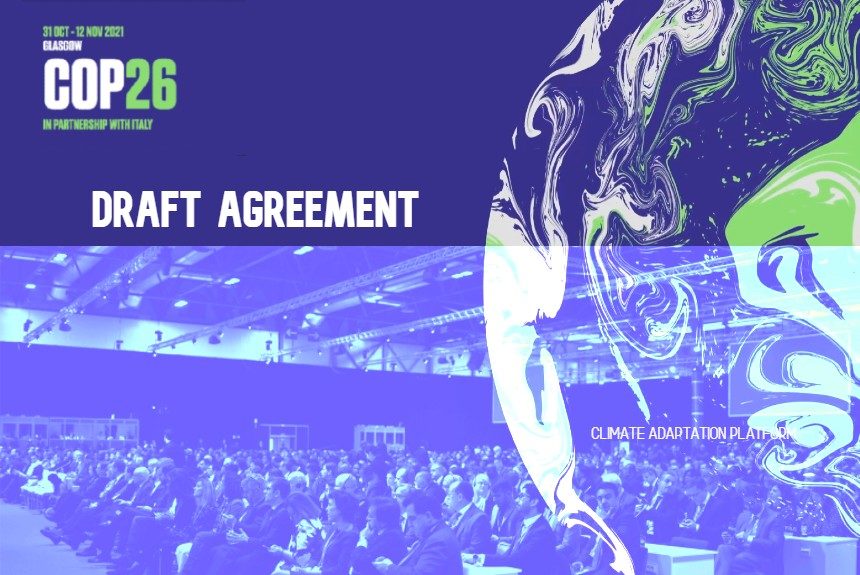As this year’s most prominent climate summit approached its final hours, Prime Minister Boris Johnson urged nations to “pull out all the stops” to limit warming.
On Wednesday, 10 November, two days before the summit ends, the COP26 presidency released the first draft agreement – considered the most critical document.
This document will not be a new treaty but a series of decisions and resolutions that builds from the Paris Agreement. It will set out what negotiators hope to get out of the summit.
It is worth remembering that the key aim for COP26 is to keep the 1.5°C alive. The IPCC has identified the 1.5-degree marker as the vital tipping point beyond which extreme weather events – droughts, wildfires, floods, and food shortages, will become irreversible.
What’s in the draft agreement?
Here are the highlights:
- Human activities are causing global warming, and its impacts are already felt in every region around the world.
- It focuses on adaptation and particularly helping developing countries deal with the effects of climate change. It urges developed countries to scale up climate finance to developing countries and deliver the US$100 billion funds promised to them.
- Keep the temperature rise to 1.5°C or below 2°C, which will “require rapid, deep and sustained” GHG emissions reductions.
- Sets up a ‘work programme’ to scale up emissions reduction.
This is a big win for the climate because this section will require countries every COP, which is every year, to address the gap between their climate pledges and their actual emissions.
- Set stronger climate targets for 2030 in line with 1.5C warming, requiring 45% emission cuts by 2030 and zero by 2050.
- Accelerate the phasing out of coal and subsidies for fossil fuels, and reduce non-carbon dioxide GHG emissions. According to the Guardian’s article , this is another major step because, for the first time, fossil fuels and coal are recognised as contributors to climate change. In the past, fossil fuels were not ‘explicitly referenced’ in the past COP decisions due to the powerful vested interest from oil-producing countries who wants to make sure that mention of fossil fuels are omitted.
- Scale-up support to developing countries and address the “loss and damage” caused by climate change both in finance and technology.
According to the Guardian article, “Cop26 draft text annotated: what it says and what it means,” this part of the agreement is a bit contentious as developing countries interpret this part to mean that they should receive compensation from the effects of climate change, but developed countries disagree with this interpretation.
In the last COP 2019, the ‘Santiago Network’ was formulated as a mechanism to address loss and damage, but this is not designed as a funding tool instead, it is a platform to share information and solutions to address the loss and damage.
Despite the COP26 promises made, the world is on track to a 2.4°C warming above pre-industrial levels, according to the report by Climate Action Tracker.
Calculations of the countries NDCs presented at COP26 show that warming will exceed the 1.5°C limits and follow a catastrophic 2.4°C degree warming.
To read more, click on this link ➝ Read the full COP26 draft agreement
What has been agreed so far at the COP26?
RNZ’s “COP26: First draft agreement published” provides a summary:
- More than 100 world leaders promised to end and reverse deforestation by 2030, including Brazil, home to the Amazon rainforest.
- The US and the EU announced a global partnership to cut emissions of the greenhouse gas methane by 2030 – reducing methane in the atmosphere seen as one of the best ways to quickly reduce global warming.
- More than 40 countries committed to moving away from coal – but the world’s biggest users like China and the US did not sign up.
- Some new pots of money were announced to help developing countries adapt to climate change and deal with the damage and loss it brings – but many say it’s not enough.
- With Wednesday named as transport day at COP26, the UK announced that new heavy goods vehicles sold from 2040 will need to have zero emissions.
Another significant development from the COP26 is the surprise agreement between China and the United States, two of the world’s top emitters. China accounts for 30% of the world’s emissions, followed by the United States at 14% (Distribution of, 2020). Their joint declaration says that both sides will “recall their firm commitment to work together” to achieve the 1.5C temperature goal set out in the 2015 Paris Agreement (COP26: China and US, 2021).
Greenpeace International Executive Director Jennifer Morgan welcomed the declaration between China and the US but warned that both countries needed to show more significant commitment to reaching climate goals (COP26: China and US, 2021).
Source Citation:
Harvey, F. (2021, 10 November). Cop26 draft text annotated: what it says and what it means. The Guardian. Retrieved from https://www.theguardian.com/environment/ng-interactive/2021/nov/10/cop26-draft-text-annotated-what-it-says-and-what-it-means
COP26: First draft agreement published. (2021 10 November). RNZ. Retrieved from https://www.rnz.co.nz/news/world/455425/cop26-first-draft-agreement-published
Distribution of fossil fuel CO2 emissions worldwide in 2020, by select country. (2021). Statista. Retrieved from https://www.statista.com/statistics/271748/the-largest-emitters-of-co2-in-the-world/
Read the full COP26 draft agreement. (2021, 10 November). CNN. Retrieved from https://edition.cnn.com/2021/11/10/world/cop26-draft-agreement-full-text-climate-intl/index.html
COP26: China and US agree to boost climate co-operation. (2021 11 November). BBC. Retrieved from https://www.bbc.com/news/science-environment-59238869
IMAGE CREDITS:
- COP 26 images by UK COP26 via Open Government Licence



Leave a Reply